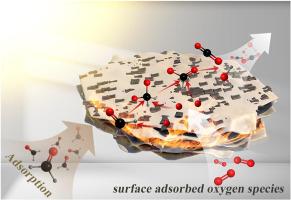Enhanced photo-assisted thermal catalytic oxidation of formaldehyde via abundant surface adsorbed oxygen in Co3O4 with the assistance of natural zeolite
IF 4.8
3区 材料科学
Q1 CHEMISTRY, APPLIED
引用次数: 0
Abstract
Photo-assisted catalytic oxidation is a promising and sustainable method for the formaldehyde (HCHO) degradation. Catalyst loading and surface adsorbed oxygen species are common strategies to enhance the efficiency of photo-assisted catalytic oxidation. In this work, acid-treated zeolite-based natural zeolites (mordenite and stellerite) were used as supports, to obtain Co3O4-natural zeolite composites by impregnation and MOF-templated methods. Under the combined action of visible light irradiation and heat condition, the photo-assisted thermal catalytic performance of different composites was determined. Among these composites, the Co-AS (Co3O4-acid-treated stellerite) composite exhibited the best HCHO mineralization performance. The use of acid-treated stellerite as a catalyst carrier effectively reduced the crystallite size of Co3O4, improved its dispersibility, and increased the surface adsorbed oxygen species, contributing to enhanced catalytic efficiency. The in-situ DRIFTs results showed that the main intermediates of photo-assisted thermal catalysis degradation were dioxymethylene (DOM) and HCOO−. Additionally, the reusability performance of the composites was also investigated. Experimental results showed that the composite had good photo-assisted thermal catalytic performance and durability, making it a promising catalyst for indoor air purification.

在天然沸石的帮助下,通过 Co3O4 中丰富的表面吸附氧增强光助甲醛热催化氧化作用
光助催化氧化是一种很有前景且可持续的甲醛(HCHO)降解方法。催化剂负载和表面吸附氧物种是提高光助催化氧化效率的常用策略。本研究以酸处理过的沸石基天然沸石(莫来石和赤铁矿)为载体,通过浸渍法和 MOF-模板法获得了 Co3O4-天然沸石复合材料。在可见光照射和加热条件的共同作用下,测定了不同复合材料的光助热催化性能。在这些复合材料中,Co-AS(Co3O4-酸处理叶腊石)复合材料的 HCHO 矿化性能最好。使用经酸处理的叶腊石作为催化剂载体可有效减小 Co3O4 的结晶尺寸,提高其分散性,并增加表面吸附的氧物种,从而提高催化效率。原位 DRIFTs 结果表明,光助热催化降解的主要中间产物是二氧亚甲基(DOM)和 HCOO-。此外,还研究了复合材料的重复使用性能。实验结果表明,该复合材料具有良好的光助热催化性能和耐久性,有望成为室内空气净化的催化剂。
本文章由计算机程序翻译,如有差异,请以英文原文为准。
求助全文
约1分钟内获得全文
求助全文
来源期刊

Microporous and Mesoporous Materials
化学-材料科学:综合
CiteScore
10.70
自引率
5.80%
发文量
649
审稿时长
26 days
期刊介绍:
Microporous and Mesoporous Materials covers novel and significant aspects of porous solids classified as either microporous (pore size up to 2 nm) or mesoporous (pore size 2 to 50 nm). The porosity should have a specific impact on the material properties or application. Typical examples are zeolites and zeolite-like materials, pillared materials, clathrasils and clathrates, carbon molecular sieves, ordered mesoporous materials, organic/inorganic porous hybrid materials, or porous metal oxides. Both natural and synthetic porous materials are within the scope of the journal.
Topics which are particularly of interest include:
All aspects of natural microporous and mesoporous solids
The synthesis of crystalline or amorphous porous materials
The physico-chemical characterization of microporous and mesoporous solids, especially spectroscopic and microscopic
The modification of microporous and mesoporous solids, for example by ion exchange or solid-state reactions
All topics related to diffusion of mobile species in the pores of microporous and mesoporous materials
Adsorption (and other separation techniques) using microporous or mesoporous adsorbents
Catalysis by microporous and mesoporous materials
Host/guest interactions
Theoretical chemistry and modelling of host/guest interactions
All topics related to the application of microporous and mesoporous materials in industrial catalysis, separation technology, environmental protection, electrochemistry, membranes, sensors, optical devices, etc.
 求助内容:
求助内容: 应助结果提醒方式:
应助结果提醒方式:


